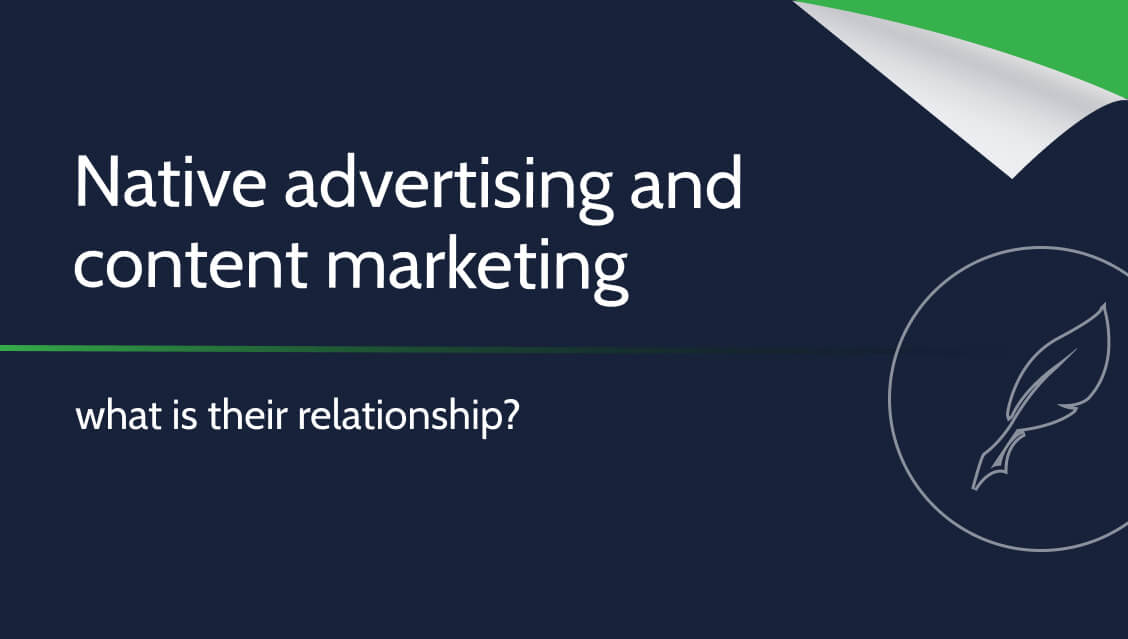Native advertising and content marketing – what is their relationship?

Throughout this blog, we have dealt with various marketing-related issues many times. Today we will talk about the concept of native advertising – and whether content can implement it effectively.
What is native advertising?
Native advertising involves presenting the product in a non-invasive, non-intrusive way that does not make it the main idea of the presented material.
We associate standard advertising with being pushy. Most often, we encounter them in the form of TV spots interrupting movies and programs, pop-ups on websites, messages interrupting songs on the radio, banners hanging outside our windows and on buildings in the city…
In other words, advertising – presented in this form – is something invasive; its very presence disturbs our impressions, whether during a screening, browsing the Internet, or admiring the views of the city. After all, even on architectural monuments and tenement houses in the Old Town there are advertisements and billboards. In response to this reluctance to deal with traditionally presented advertising, a new concept was created – native advertising.
Its aim is to signal to a potential buyer the presence of a product, its features and possible benefits, but this is not the primary goal – the positive impressions of a given person are such. Therefore, first of all, he should be intrigued by the content, and the information about the advertised element cannot dominate the rest of the message.
What does it look like in practice?
A well-constructed native ad is an article (or a video or any other medium) that primarily presents some information; in other words, its axis is not the product itself, but some issue in which – for example – this product can help. It is therefore in opposition to measures or concepts such as CTA (call-to-action) or outbound marketing.
After reading the advertisement, the recipient should not even be aware of the intention of its existence; the presented material should be a coherent whole even after excluding the aspect presenting a product.
The biggest advantage of this solution is the almost complete elimination of traditional features negatively associated with advertising. Instead of persuading, he introduces himself. Instead of exhorting, one suggests. Instead of pointing it out, it is mentioned in passing.
Customers will be more willing to buy a product if the idea of purchasing it comes from themselves – and such results are possible thanks to the concept of native advertising.
What is not native advertising?
However, let us immediately dispel any associations or incorrect approach to the topic. First of all, native advertising cannot be achieved by including a mention of a product in any text. Advertising must, above all, be naturally integrated into the content – constitute its extension, but not determine the validity of the presented material.
For this reason, sponsored articles, which are informative texts that also present a product, are not a native way of advertising. This boundary is quite tenuous, so we will describe it in detail below.
The mentioned axis of native advertising is not a product – it is an issue; The same cannot be said about a sponsored article, the purpose of which is to directly persuade people to purchase a product/use a service. This form of the article will most likely refer to methods of comparison with other alternatives available on the market or their discredit; Native advertising is unrelated to other market elements and does not attempt to position itself relative to them. This is a comparison of two different methods – persuasion versus suggestion. The former uses more aggressive means, the latter only uses associations.
Let’s present them with an example. We want to advertise climbing equipment. If we commission the creation of content that will describe individual pieces of equipment (e.g. “The best alpine ice axes”, among which our brand would be the leader), we are dealing with a traditional advertising article.
However, if we would like to do it more subtly, we can commission content to be written about the most difficult Polish mountain trails – and include information about ice axes, which are necessary for this type of challenges. The text will present its value, even if we include information about our product, and in addition, for the reader this information will be a natural extension of the knowledge already included. This is what native advertising is.
What is the relationship between native advertising and content marketing?
To put it simply, opinions are divided, so it can probably be said that the relationship is ambiguous.
Content marketing – i.e. advertising with content – is assumed to provide recipients with high-quality, valuable content on a given issue. A lot depends on the type of content – i.e. its type, destination of publication, length, etc. – but both belong to a common field, i.e. marketing. The task of both is to present the product through some content in an engaging and encouraging way.
Are these synonyms? It seems that not necessarily – after all, content marketing assumes a broader scope of activities. However, native advertising can be a useful concept in content efforts.
Content marketing is therefore an effective form of implementing the assumptions of native advertising.
Content creators are able to create texts in line with the idea of native advertising, and native advertising has its advantages, discussed above. Although perhaps not every product can be advertised in this subtle way, it is worth keeping this method in mind when planning and implementing further marketing strategies.
Summary
- Native advertising is a non-invasive advertising tactic opposed to traditional techniques that aim to persuade the recipient to purchase a given product;
- Its assumptions can naturally be implemented by content marketing.


















Leave a Reply